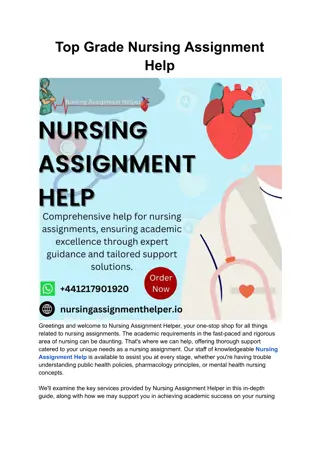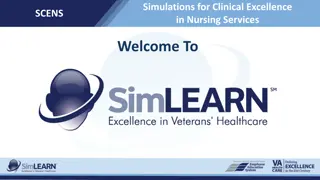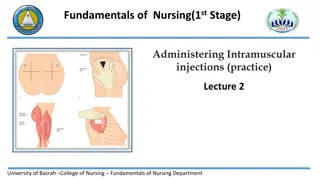Intravenous Injection: Fundamentals and Practices in Nursing
Intravenous injection is a crucial method for administering medications directly into the bloodstream. The process involves introducing medications quickly and efficiently through a vein using an IV access. While IV bolus allows for rapid delivery, it requires careful monitoring to avoid adverse reactions. Understanding the importance, precautions, and advantages of IV injections is vital for healthcare professionals.
Download Presentation

Please find below an Image/Link to download the presentation.
The content on the website is provided AS IS for your information and personal use only. It may not be sold, licensed, or shared on other websites without obtaining consent from the author.If you encounter any issues during the download, it is possible that the publisher has removed the file from their server.
You are allowed to download the files provided on this website for personal or commercial use, subject to the condition that they are used lawfully. All files are the property of their respective owners.
The content on the website is provided AS IS for your information and personal use only. It may not be sold, licensed, or shared on other websites without obtaining consent from the author.
E N D
Presentation Transcript
Fundamentals of Nursing(1stStage) Intravenous Injection (Practice) Lecture 3 University of Basrah College of Nursing Fundamentals of Nursing Department
Introduction Some medications must be given by an intravenous injection or infusion(I.V) . This means they re sent directly into vein using a needle or tube. In fact, the term intravenous means into the vein.
An I.V bolus: is one method of medication administration currently practiced on patient care units. It introduces a concentrated dose of a medication directly into a vein by way of an existing IV access. Administering medications by IV bolus is common in emergencies when deliver a fast-acting medication quickly. It is essential to monitor patients closely for adverse reactions because these medications act quickly.
Take into Account Take into Account 1. The IV bolus is a dangerous method to administer medications because it allows no time to correct errors. 2. Administering an IV push medication too quickly can cause death. Therefore be very careful in calculating the correct amount of the medication to give. 3. A bolus may cause direct irritation to the lining of blood vessels; thus always confirm placement of the IV catheter or needle. 4. Never give an IV bolus if the insertion site appears edematous or reddened or if the IV fluids do not flow at the ordered rate. 5. Accidental injection of some medications into tissues surrounding a vein can cause pain, sloughing of tissues, and abscesses.
Uses of I.V injections 1-In some situations, people must receive medication very quickly. This includes emergencies, such as a heart attack, stroke, or poisoning. In these instances, taking pills or liquids by mouth may not be fast enough to get these drugs into the bloodstream. IV administration, on the other hand, quickly sends a medication directly into the bloodstream. 2-Medications may need to be given slowly but constantly. IV administration can also be a controlled way to give drugs over time.
3-Certain drugs may be given by IV administration because if you took them orally (by mouth), enzymes in your stomach or liver would break them down. This would prevent the drugs from working well when they re finally sent to your bloodstream. Therefore, these drugs would be much more effective if sent directly into your bloodstream by IV administration.
Advantages of I.V Route 1. There which critical 2. Medications given 3. Doses titrated responses important patients. 4. Method medication is left is is or rapid useful emergent can a shorter short-acting medications based on a to the drug for infants, onset in of medication patients health be prepared time. effects, experiencing problems. quickly and over of can be and is older patient s therapy. children, needs This and provides delivered in intravenously. a more accurate because dose medication of no
Disadvantage 1. Not all medications can be delivered by IV push. 2. There is higher risk some are mild to medication action peaks 3. When giving medication quickly 1 minute), there is to stop the injection occurs. 4. Hypersensitivity reaction immediate or delayed medication, requiring for infusion severe quickly. reactions; the because (e.g., opportunity adverse less than very if little an reaction can cause systemic supportive an reaction measures. to a
Best Practices for Administration of Intravenous Best Practices for Administration of Intravenous Solutions and Medications Solutions and Medications 1. Use standardized concentrations of medication. 2. Use standardized procedures preparing, and administering medications. 3. Administer solutions and dispensed from the commercially prepared 4. Use standardized infusion high-alert medications. 5. Standardize the storage 6. Use standardized label name, generic drug name, dose. and dosages for ordering, intravenous (IV) and medications pharmacy when possible. concentrations prepared as or of of IV medications. Bold patient-specific practices. and patient
EQUIPMENTS 1. Syringe with needle. 2. Drug to be administered (without air). 3. Tourniquet. 4. Antiseptic hand rub, clean gloves. 5. Adhesive tape, antiseptic solution, and cotton wool. 6. Medication administration record (MAR) 7. Puncture-proof container
Nursing Diagnosis 1. Acute pain 2. Deficient knowledge regarding medication therapy
Procedure 1. 2. Close room curtain or door Identify patient using two identifiers (i.e., name and birthday or name and account number). Compare identifiers in MAR with information on patient s identification bracelet and/or ask patient to state name. At patient s bedside again compare MAR with names of medications on medication labels and patient name. Perform hand hygiene and apply clean gloves. Identify best vein by applying light pressure to inject medication. Apply tournique (4 to 6 inches) above proposed insertion site and clean insertion site with antiseptic solution in one circular motion. Allow to dry. Insert needle in 45 degree and inspect for blood return into syringe which mean correct site. Remove tournique and inject medication within amount of time recommended. Use watch to time administration. After administering bolus, withdraw syringe 10. Dispose of covered needles and syringes in puncture-proof container. 3. 4. 5. 6. 7. 8. 9.
Signs of good vein Veins should you avoid Bouncy Thromboses Soft Inflamed Refills when depressed Bruised Visible Thin Has a large lumen Near bony prominences Straight Areas or sites of infection, edema or phlebitis Have undergone multiple previous punctures. Easily palpable
Cannulation Cannulation
Intravenous cannula Is a tube that can be inserted into a vein, primarily for the administration of intravenous fluids, obtaining blood samples and for administering medications.
Indications 1. Fluid and electrolyte replacement. 2. Administration of medications. 3. Administration of blood/blood product. 4. Administration of Total Parenteral Nutrition. 5. Blood sampling.
Size of intravenous cannula Cannula come in various colors, which correspond to the size of the tube . The size needed depends on what it to be infused e.g. colloid, crystalloid, blood products or medications; or at the rate the infusion is to run. The other factor which could determine which size to use is the patients veins e.g. you may only get a small blue cannula into an elderly patient who has spindly veins.
Size Color 14G Orange 16G Grey 18G Green 20G Pink 22G Blue 24G Yellow 26G Violet
EQUIPMENTS I.V cannula Tourniquet. Antiseptic hand rub, clean gloves. Adhesive tape, antiseptic solution, and cotton wool. Normal saline, syringe.
Procedure 1. Perform hand hygiene, applying clean gloves. 2. Select a well-dilated vein. Use most distal site in nondominant arm if possible 3. Apply tourniquet (4 to 6 inches) above proposed insertion site. Choose site that will not interfere with patient s activities of daily living (ADLs). 4. Anchor vein below site by placing thumb over vein and gently stretching skin against direction of insertion 4 to 5 cm distal to the site. Instruct patient to relax hand. 5. Clean insertion site with antiseptic solution in one circular motion, allow to dry. 6. Insert bevel in 45 degree into vein and observe for blood return through flashback chamber of catheter, indicating that bevel of needle has entered vein.
Procedure 7. Loosen stylet of over-the-needle catheter. Continue to hold skin taut while stabilizing needle and advance catheter off needle to thread just the catheter into vein until hub rests at venipuncture site. Do not reinsert stylet once it is loosened. 8. Stabilize catheter with nondominant hand and release tourniquet with other. Apply gentle but firm pressure with middle finger of nondominant hand 3 cm above insertion site. Keep catheter stable with index finger. 9. Secure cannula, dispose stylet. Remove clean gloves and perform hand hygiene.
Possible Complication 1-Hematoma: a collection of blood, which can result from failure to puncture the vein when the cannula is inserted or when the cannula is removed. 2-Infiltration : when infuscate enters the subcutaneous tissue instead of the vein. 3-Embolism: this can be caused by air, a thrombus, or fragment of a catheter breaking off and entering the venous system. 4-Phlebitis: an inflammation of the vein resulting from mechanical or chemical irritation or from an infection.
Phlebitis Scale Grad Clinical Criteria 0 No symptoms 1 Erythema at access site with or without pain 2 Pain at access site with erythema and/or edema 3 Pain edema Streak Palpable Pain edema Streak Palpable length Purulent at access site with erythema and/or formation venous access cord site 4 at with erythema and/or formation venous cord >1 inch (2.5 cm) in drainage























